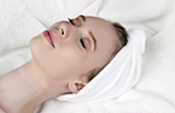Professional Microdermabrasion and Dermabrasion
Difference between these two aggressive exfoliation treatments |

Many people think microdermabrasion and dermabrasion are the same thing. Their names sound similar, but these two facial procedures happen to be very different.
Keep reading to learn what they are, how they are different, and what skin conditions they treat.
Professional Microdermabrasion
Microdermabrasion is a facial procedure that deeply exfoliates the surface of your skin. Professional microdermabrasion treatments are completely different from at-home microdermabrasion kits, which are more like fine scrubs. While at-home microdermabrasion kits can make your skin feel very soft and smooth, the results do not compare to professional microdermabrasion treatments.
Professional microdermabrasion is much stronger and can reduce the appearance of light wrinkles, scars, and hyperpigmentation. They help even out your skin tone and rejuvenate a dull complexion. Professional microdermabrasion procedures are usually recommended for anti-aging or fading dark marks, but some dermatologists will suggest them as acne treatments. Microdermabrasion can help with active acne, but the extent of improvement depends on how your skin responds. It would probably take multiple treatment sessions as well.
Microdermabrasion is becoming increasingly popular at spas and dermatologists’ offices. Like chemical peels, you can purchase microdermabrasion treatments as packages (of either 5 or 6) because you will need more than one anyway to get your desired results. You generally get microdermabrasion spaced one month apart to give your skin ample time to heal and regenerate.
There is little to no downtime associated with professional microdermabrasion. Your skin might be red and pink for the rest of the day and maybe even the next day, but that's about it. Some people also experience dryness or tiny breakouts after the treatment, as it brings clogs in your skin closer to the surface. Because microdermabrasion is exfoliating and makes your skin more sensitive to sunlight, it is imperative to protect your skin against UV rays by wearing a photostable sunscreen.
Professional microdermabrasion is performed using either a diamond tip or tiny crystals. With crystal microdermabrasion, tiny crystal particles are used to exfoliate your skin. With the diamond tip, a wand-like device with a "diamond tip" is used to exfoliate your skin instead. Both of these methods exfoliate your skin and use a sucking motion to suck away the exfoliating grains and any dead skin cells.
It is this sucking motion that many people believe helps regenerate collagen in your skin. However, there isn’t much evidence backing up this claim. If you have skin prone to broken capillaries, you may want to avoid microdermabrasion because the suction could be overly irritating and cause even more broken capillaries to form.
I have personally tried a series of professional microdermabrasion treatments for my acne, but they did nothing. My skin was neither better nor worse so it was pointless for me to continue getting these facials. Your experience might be different though, since everyone's skin responds differently to different things.
Overall, professional dermabrasion is one out of many facial procedures that you can use to make your skin look better, brighter, and younger.
Dermabrasion
Professional dermabrasion is not the same as professional microdermabrasion. Unlike microdermabrasion, dermabrasion is a much more serious cosmetic procedure.
In dermabrasion, the surface of your skin is literally sanded away with lasers or mini-electric sanders, though the sanders are less common now. You will usually be given anesthetics (or a numbing cream like lidocaine on your face) before the procedure because this treatment can be very painful. Oral painkillers and antibiotics might also be prescribed for post-dermabrasion care.
Similar to TCA peels, there is significant downtime associated with dermabrasion. Your skin will be red and irritated for several weeks until it gradually heals and regenerates. This long recovery time may be a turn off for some people, but others find the side effects of dermabrasion worth the skin improvements from the treatment. Because dermabrasion is such a deep and aggressive procedure, it can make your skin a lot better but definitely not without risk. If recovery goes well, results can be really great. But if something goes wrong, it can go really wrong. Dermabrasion is a high risk, high reward type of treatment.
For both microdermabrasion and dermabrasion treatments, make sure to stay out of the sun and wear a good sunscreen. Before you get any of these procedures done, make sure the person giving you the treatment is a qualified professional who understands your skin type and what skin issues you wish to fix. Ask your friends for good aestheticians, dermatologists, or plastic surgeons. Do proper research about the procedure so you fully know what to expect and how to care for your skin afterwards. Don't be like me.
Professional microdermabrasion and dermabrasion can make your skin look better, but they have side effects and risks, so make sure you know what you are getting into when you sign up for one of these procedures.
Last updated: September 20, 2012
Related articles:
- How I Cleared My Skin
- My Glycolic Acid Peel Experience
- How to Choose the Right Sunscreen
- Facial Procedures: Cosmetic Lasers
- FAQ: What is Hydroquinone and Why is it Bad?
